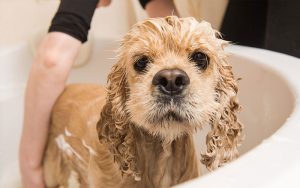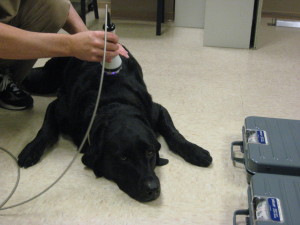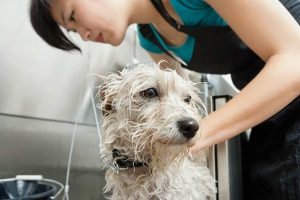Posts by Dr. Lelan Olsen
Dr. Olsen’s Breed Spotlight: The Lowchen
 The month of February is reserved to spotlight a dog breed. Most of the time, I try to shed some light on a breed that isn’t very popular. Well this month is no exception as I am featuring a dog that is not very popular, unique in its appearance, rich in history and really considers its only job as being a companion for its owner. That breed is the Lowchen, which is also known as the “Little Lion Dog”.
The month of February is reserved to spotlight a dog breed. Most of the time, I try to shed some light on a breed that isn’t very popular. Well this month is no exception as I am featuring a dog that is not very popular, unique in its appearance, rich in history and really considers its only job as being a companion for its owner. That breed is the Lowchen, which is also known as the “Little Lion Dog”.
The Lowchen is a small breed that generally stands about a foot tall but has an enormous heart. The coat is traditionally kept in a “lion clip” in which most of the hind quarters and tail are clipped down close to the skin. The overall effect is that of a mini lion with a full mane and plumed tail. This breed coat comes in many colors and color combinations.
The breed has a long and somewhat controversial history. We know from works of art depicting images of small dogs in a very distinctive lion trim from the breed dated to the 16thcentury. The breed has been depicted throughout the centuries in paintings, drawings and tapestries from around the world.
The controversy arises as to the exact origin of the breed. There are several theories of debate with one thinking that the breed originated in Northern Europe which is now known as Germany, France and Belgium. Because it came from this area, the Lowchen is thought to be tied to the breeds that were the forerunner to the modern day poodle. The stories go that they were a favorite companion for the ladies of the castles and they would lay close to their owners at night to keep them warm like a water bottle, as well as attract the fleas away from the owner.
Another theory is that the Lowchen originated in the Mediterranean region and are directly related to the Bichon breeds. Also there are some theories that the breed might have originated in Russia or Tibet.
The Lowchen has been a resident of all households through the ages, from castles to farmyards and cottages. Aside from the function of being a companion, they possibly were varmint hunters and fierce little guards.
There is a story from the late 1700’s about a Lowchen whose name was Bijou. As the story goes, Bijou was so upset that his owner was leaving him behind, he jumped out of a castle window into the Lahn River that was 60 feet below. One ending has him surviving and was rewarded by riding to the hunt in the owner’s saddle, the other that the jump ended in disaster. Whichever the outcome, his portrait from 1787 still hangs in the Baronesses’ bedroom in Wellburg Castle.
Little has been written about this breeds early years. The first record of a breeder and fancier was Dr. Walthier in Germany in the 1800’s. The breed standard was written in the 1800’s and in 1897, a Madame Madelaine Bennert purchased her first Lowchen. She is the one who would be recognized for her efforts in saving the disappearing breed.
In 1999, the Lowchen was admitted into the AKC in the Non-Sporting group. The Lowchen is a small breed that weighs about 15 pounds and has a life expectancy or about 13-15 years. It is a very loving dog whose sole purpose is giving love and hoping to get loved in return. It might see a squirrel, chase it and catch it, but it would not know what to do with it if it did catch it. It will bark at strangers, but then when they enter, the Lowchen will lick them to death. The Lowchen’s favorite spot to be is on the couch watching out the window.
Don’t mistake the breeds sweetness, because it is a true lion that will stand up to any German Shepherd and bark down a Great Dane. They are active, smart, and love children. They can make very good agility dogs because they are trainable, resourceful and very adaptable. Since they like to bark, it is recommended that they undergo some obedience training. Due to their haircoat it is advisable that they be brushed regularly and see an experienced groomer monthly. Another plus with this breed is that they are hypoallergenic.
There are very few health problems with this breed. But they may suffer from patellar luxations, heart issues and some eye issues.
Here at the Olsen Veterinary Clinic, we love to see all breeds. So if you have a Lowchen, or a mixed breed, gives us a call at (618)-656-5868 and we will be happy to assist you.
How Often Should I Bathe My Dog?
 We as humans bathe at least once daily. Right? So should pets get bathed daily also? This is one of the questions that we get from pet owners regarding their four-legged family member. Generally my answer to the question would be no, but there are many factors that go into determining the proper frequency.
We as humans bathe at least once daily. Right? So should pets get bathed daily also? This is one of the questions that we get from pet owners regarding their four-legged family member. Generally my answer to the question would be no, but there are many factors that go into determining the proper frequency.
Obviously if your pet has been running and playing outside a lot and they are dirty and very odorous, then they possibly should be bathed. But why do we even bathe our pets? The easy answer is for its health. Without one, your dogs’ skin could get irritated and infected and its coat could get matted and hard. A dog’s breed, coat characteristics, and other variables play a factor in this.
So how often do we bathe a dog? The top reason is when the smell. Easy rule of thumb is if it smells beyond just normal dog smell, it’s time for a bath. If you are unsure about the skin, I would recommend talking to experts in the field like your veterinarian or a professional groomer. They can help you understand what may be the best options for your pet.
If your pet has skin issues, it may be prescribed a medical shampoo. As a dermatological professor told us—if it is wet, you want to dry it and if it is dry you will want to add moisture. Unfortunately, there is not one shampoo that will do both.
As human’s have different hair and skin issues, so do dogs. Some breeds are double-coated breeds. These breeds like the Samoyed, Alaskan Malamute and the Chow Chow most likely will require less frequent bathing but more brushing to keep their coats healthy and clean. By contrast, a breed like the Bassett Hound has a more oily coat, so it may require more frequent bathings. Short haired breeds like Dalmatians and Weimaraners tend to require very few bathings as they can regulate their natural oils without much help.
Now that we have determined factors that play into bathing your pet, what do we buy? First you will need a shampoo that will be appropriate for your pet as we have discussed previously. Secondly, some lukewarm water. Hot water can burn your pets skin and dry it out. Rule of thumb– the cooler the better. A good brush is good to have on hand. Prior to bathing it is best to comb out your pet and shed any dead hair. By combing agains the coat, you can prevent mats and help spread out your pet’s natural oils. Be sure that you have towels on hand to wipe them dry. I do not recommend using a blow dryer as the heat will dry out the skin. There are also dry shampoos out there that you can use to spray them down with and wipe it off without having to bathe them to preserve the natural oils.
So you are still confused about bathing your pet? Remember that we are always here to assist you, so please don’t hesitate to call us at (618)-656-5868.
Pet Gift Guide For The Holidays – 2018
 Christmas is a time for giving, so why not give something to that family member that is there for you unconditionally. No I am not talking about your spouse or children—I am talking about your pet. Throughout the year, I make note of items or websites that can offer quality and safe products for your furrbaby. While most are websites that have quality products, I have included a few toys that may be attractive to you and your pet.
Christmas is a time for giving, so why not give something to that family member that is there for you unconditionally. No I am not talking about your spouse or children—I am talking about your pet. Throughout the year, I make note of items or websites that can offer quality and safe products for your furrbaby. While most are websites that have quality products, I have included a few toys that may be attractive to you and your pet.
- Petsafe Busy Buddy dog toys – There are many toys made by this company including the Nobbly Nubbly Dog Toy. This company makes playtime with your pet last longer by dispensing treats as your pet plays. The toys are designed for specific purposes or specific kinds of play.
- Bumble Ball Motorized Dog Toy – This toy is a “blast-from-the-past”. It is a retro toy brought back from the early 1990’s. Your pets go crazy trying to catch the bumpy ball. Pets are entertained with unpredictable jumps, shakes, wiggles and bumbles. This is not a chew toy and is not recommended for aggressive dogs.
- Barkbox.com– Who doesn’t like to receive packages in the mail. Your pet will. This is a company that sends out boxes monthly for your pet that is similar to the fruit of the month subscriptions but it is for your pet. You can order a 6 or 12 month plan so that every month you will receive a box that contains 2 toys that are not fuzzy, 2 full bags of treats, and 2 meaty chew treats. The costs for the boxes start at $29, but you will get over a $45 value in each box.
- Meowingtons.com –For the cat fanciers that are trying to find the purrfect gift for the cat lover or their pet. The company has a selection of items for the owner and pet toys to keep the cat active or looking cute.
- Pet DNA testing –There are many companies out there, but these tests are available for both cats and dogs. By knowing the breed makeup of your pet, you can get an idea of what issues might be forthcoming to your pet due to its breed.
- Tipsyelves.com– Ooh, baby it is cold outside. We can’t let our fur babies go outside without them being protected from the elements this holiday season. So why not get them a festive sweater to help make them look dapper and in the holiday spirit. These are quality products that come in a number of different styles.
At this time, I would like to thank all of my clients for making 2018 a prosperous year and wish each and every one of you a joyous holiday season. If you have any questions please do not hesitate to contact us or give us a call at 656-5868.
What To Do When Your Pet Is A Handful – And You Are Leaving Town
 You are about to experience the trip of a lifetime, but there is only one problem. You have a pet that is very unruly and it is hard to leave it behind because all your friends and family scatter when asked to take care of it. Have you ever had that scenario? I am sure a few of the readers have. So what options are out there that will give you piece of mind that your pet will be taken care of?
You are about to experience the trip of a lifetime, but there is only one problem. You have a pet that is very unruly and it is hard to leave it behind because all your friends and family scatter when asked to take care of it. Have you ever had that scenario? I am sure a few of the readers have. So what options are out there that will give you piece of mind that your pet will be taken care of?
Family/Friend:
Consider taking your pet to a friend or family member that has pets, but make sure they are accustomed to each other. Friends that are also pet owners are very likely to be able to handle a pet that is a handful.
Pet Sitter:
Another solution may be to hire a pet sitter that will stay in your home 24/7. That way your pet will not need to leave your house and can retain their comfort and schedule in your own home. Professional pet sitters are typically well equipped to handle pets that are rambunctious.
Dog Kennels:
A not so new trend is the dog kennels. Marketing has kindly changed their names to pet hotels. Your pet may actually enjoy it. A lot of them offer daycare also, so you may consider taking them for daycare or a weekend prior to you leaving. If they enjoy it, then you may feel better about leaving them there. Some also have pet cams so that you may be able to check in on them anytime day or night. Make sure you bring your pet in before going, as most establishments require your pet be up to date on vaccinations.
Lastly, a refresher obedience class can be a good idea. Positive-reinforcement or private classes make work best.
With the upcoming holiday season, our readers may happen to have this situation. The Olsen Veterinary Clinic can offer advice to our clients and give them some options that are out there. Please call the office at (618)-656-5868 for questions or comments.
Dr. Olsen’s Breed Spotlight: Pixie-Bob Cat
 Dogs are considered “man’s best friend.” But what do you get when you don’t have room or time for a dog? How about a cat that thinks it’s a dog? The breed of cat that I am spotlighting this month has been described as that. It is called the Pixie-Bob.
Dogs are considered “man’s best friend.” But what do you get when you don’t have room or time for a dog? How about a cat that thinks it’s a dog? The breed of cat that I am spotlighting this month has been described as that. It is called the Pixie-Bob.
The Pixie-Bob breed is thought to be the result of the natural mating between a bobcat and a domestic shorthair, but they may also have sprung from a natural genetic mutation that gave them their wild look and bobbed tail. It is one of those mysteries that no one will ever know for sure. This breed was first developed in the Pacific Northwest in the mid 1980’s by a woman that acquired a male kitten with distinctive characteristics like a spotted coat, a short tail and more than usual numbers of toes. A year later, she acquired another male cat with a short tail and with the help of a neighbor’s female cat, produced a litter of kittens. One, a female, had a muted spotted pattern and the woman kept her—naming her Pixie. The breeder wanted more cats like Pixie, and soon the breed was born. They were recognized as an actual breed by the American Cat Fanciers Association in 2005.
Pixie-Bobs are described as “big, lively and outgoing.” The breeds’ devotion to its family belies its somewhat wild look. They tend to be a large cat where the male and female can weigh up to 12 and 25 pounds respectively. They are brawny and muscular which is why some breeders believe that the Coastal Red Bobcat had to be the founding father. Their ears tend to be tufted and resemble that of a bobcat by having lynx tips on the ears. Pixie-Bobs have a thick wooly coat like a bobcat and can be either long or short haired. They normally have a striped coat pattern and come in a variety of colors, but most are tawny, light gray, or reddish. Their eye color can be from golden brown to gooseberry green. A Pixie-Bob’s tail is a minimum of 2 inches by can be as long as to their hock. Their facial hair grows downward giving them the appearance of a man’s muttonchop sideburns. One other unique feature that some Pixie-Bobs have are that some are polydactyl. This means that they have more than the usual number of digits on its paws. Polydactyl cats are considered lucky, so if you own a Pixie-Bob, luck may be on your side.
Pixie-Bobs are inquisitive and like to interact with families, so they are true companions and members of the family because of their relaxed attitude. They communicate with their families with a pleasant voice and standard meows and purrs. They are active and enjoy being friends. They enjoy interaction with families and have been described by some as “the cat that thinks it is a dog.” Pixie-Bobs love going on car rides and walks just like dogs. They also get along well with dogs and other pets. Because they tend to be a medium to long haired breed, they do require a weekly brushing to prevent mattes from forming and regular nail trims.
If you have a Pixie-Bob cat or even a good ol’ domestic shorthair, the Olsen Veterinary Clinic tries to meet the expectations for all of your pet’s needs. If you have any questions or issues please do not hesitate to call us at (618)-656-5868.
Dog Park Safety Tips
 With the pet business becoming a multi-billion dollar business in recent years, it is telling us that more and more people have pets and are taking care of them. Among the fads, if you want to call it that, are “doggy daycares”, mobile groomers and dog parks. A lot of these services are great ideas as far as convenience is concerned, but how safe are they to our pets? Especially the dog parks.
With the pet business becoming a multi-billion dollar business in recent years, it is telling us that more and more people have pets and are taking care of them. Among the fads, if you want to call it that, are “doggy daycares”, mobile groomers and dog parks. A lot of these services are great ideas as far as convenience is concerned, but how safe are they to our pets? Especially the dog parks.
No, I am not going around and saying that dog parks are bad for you dog, but there could be some hidden dangers that may be lurking for the unprotected dog. Most dog parks are public places, so there is a good possibility that not all dogs are properly vaccinated against diseases such as Parvovirus, Roundworms, or even Kennel Cough. These diseases can occur during direct contact with another dog, or even if your pet has licked an area that harbored the diseases or parasites. So my advice is to make sure that your pet is currently vaccinated for all diseases. If they’re not—do not take them there. It is not worth it to possibly expose your pets to those diseases if you can help it.
We all see the dogs being playful in the park, but how do we know that the other pets can’t become overly aggressive? Because of this, I would recommend that your pet be kept on its leash. I know that is not the reason for dog parks, but that way you can control your pet if they or another pet exhibits some aggression so that you may prevent injury and not be faced with a costly veterinary visit.
If you allow your pets to run free in the park, injuries such as torn cruciates and other lamenesses can occur. To reduce this possibility, it might help to train your pets for the rigors that a dog park presents.
Dog parks are popping up in a lot of the communities. Realize that just because they are in a fenced in environment, they are not always completely safe. If you have any questions or issues, please feel free to contact us or give us a call at 618-656-5868.
How To Help Your Pet That Has Arthritis
 Everything gets older, including our pets. Sometimes this can lead to arthritic pain in their joints. Depending on the breed and size, arthritic changes can occur at an early age or later in life. No matter when symptoms start occurring, we as owners want to limit the pain and slow down the progression of the arthritic changes so that our pets can have a long, relatively pain-free life.
Everything gets older, including our pets. Sometimes this can lead to arthritic pain in their joints. Depending on the breed and size, arthritic changes can occur at an early age or later in life. No matter when symptoms start occurring, we as owners want to limit the pain and slow down the progression of the arthritic changes so that our pets can have a long, relatively pain-free life.
The joints maintain their ability to function because of the joint fluid that is produced by the cartilage that lines the joints. If the cartilage is damaged, it heals and repairs itself, but it is replaced by bone. And bone does not secrete joint fluid. So as the bone is replacing the joint cartilage, there is less joint fluid. With less joint fluid, there is more pain.
So when we get to the point where there is arthritic changes, what can we do to ease the pain and maintain relatively pain free function? There are many options for us to explore that will aid in slowing the progression of the arthritic changes which might range from supplements to surgical replacements or procedures.
Sometimes a supplement like glucosamine can help by reducing the inflammation of the cartilage of the joint. This product is relatively inexpensive and is available at pet stores along with being supplemented in the pet’s food. A product that I use called Adequan also assists the joints by slowing the breakdown of the joint fluid to provide better viscosity and lubrication. Here at Olsen Veterinary Clinic, I routinely will use a therapeutic laser to aid in the reduction of inflammation and pain in the joints. I have found that it can benefit the pet.
A lot of times, we will prescribe a nonsteroidal anti-inflammatory like Deramax or Previcox that will reduce the inflammation in the joints and ease the pain that the arthritic disease causes. There are numerous NSAID’s out there that we use with some being once or twice daily dosing.
Recently, medical and surgical procedures have been developed that can assist your pet with arthritis. These may include Stem Cell Therapy, joint replacement, or other procedures that will alter the joint itself for better pain free articulation.
Arthritis in pets is very common and we have many options at our disposal that won’t break the bank for the owners. Please give us a call at 618-656-5868 or contact us here for some options that may be available for you and your pet.
Is Your Cat Scratching Up Your Furniture?
 Is your cat scratching up your furniture? Many people who own cats can vouch that their cats have four appendages that most know how to use to efficiently destroy the furniture in the humans home or the human’s other belongings. Every now and then, I am faced with doing a declaw on some our furry feline patients. Not only can they be pricey, but it can be one of the more tedious and frustrating surgeries with some possible complications arising.
Is your cat scratching up your furniture? Many people who own cats can vouch that their cats have four appendages that most know how to use to efficiently destroy the furniture in the humans home or the human’s other belongings. Every now and then, I am faced with doing a declaw on some our furry feline patients. Not only can they be pricey, but it can be one of the more tedious and frustrating surgeries with some possible complications arising.
Cats mark their territory by scratching, much like dogs urinate to mark their territory. Cats have scent glands on their paws, so when they scratch, they leave it on that area. This also marks visually by leaving the shredded material behind as evidence and displaying dominance to other submissive cats. Scratching also allows the cat a way to exercise and stretch along with removing their old sheaths.
So what are some alternatives that owners can try to avoid having the declaw surgery which is actually an amputation of the bone at the distal joint? Well, a person may supply their pet with a scratching post or pads to develop healthy scratching habits. By applying catnip or treats, you can attract them to their designated scratching areas.
A no cost procedure would be to trim their nails every one to two weeks. This will cut down on the need to scratch as much. This is easiest to do if you start when they are kittens.
There are double-sided tapes that can be put on furniture that is unpleasant for cats. The use of pheramones like Feliway sprayed on the tape can also reduce the cat’s desire to scratch.
Lastly, there are nail covers like Soft Paws to place over the nails. They are only temporary, so they will need to be changed regularly as the nails grow.
To avoid the destructive behavior of cats, cat owners must be willing to invest time and money. If not, there is always the surgical route one can go. If you need advice or help with this or any other issues, please don’t hesitate to call us here at the Olsen Veterinary Clinic. The phone number is (618)-656-5868.
How To Remove Tree Sap From Your Dog’s Fur
 Dogs seem to get into ugly predicaments during the summer. If they like to wander, sometimes they may come back with that sticky tree sap that can cause debris like rocks or pine needles to stick to their paws. This can sometimes be quite painful and it leads to an owner figuring out how to remove the sap from your pet. Some types of sap can be toxic if ingested or cause irritation if it comes in contact with your pet’s skin, so it is important to work quickly to remove it.
Dogs seem to get into ugly predicaments during the summer. If they like to wander, sometimes they may come back with that sticky tree sap that can cause debris like rocks or pine needles to stick to their paws. This can sometimes be quite painful and it leads to an owner figuring out how to remove the sap from your pet. Some types of sap can be toxic if ingested or cause irritation if it comes in contact with your pet’s skin, so it is important to work quickly to remove it.
Fortunately, removing tree sap is an easy process and can be done using common household items. Below are some steps that I recommend to remove sap from the fur.
- If the sap is hardened, it will need to be softened using a hair dryer set on its lowest setting. Test the dryer first with your hand to find a safe distance where the air feels warm but not hot.
- Loosen the sap by using olive oil, mineral oil, or smooth peanut butter. Massage the product onto the affected fur and let it sit a few minutes. It is important to only use products that are safe if ingested, since your pet may try to lick the oily substance off its fur.
- Use your fingers and a wide-tooth comb to carefully and slowly work the sap out of your pet’s fur. As you go, you can wipe some of the oily product and residue with a washcloth or paper towel.
- If there are stubborn patches near the tips of the hair, you can carefully trim them with a scissors, making sure to avoid cutting too close to the skin.
- Do a final cleanse with a pet friendly shampoo and warm water. You may need to shampoo the area more than once to get all of the oily product out.
To remove sap from the feet, massage the area with the products listed above and them bathe them in a pet shampoo. The stubborn areas of fur around the paws may need the assistance of a groomer if you do not feel comfortable with that area.
As stated before, work quickly because that sap can cause some local irritation and digestive issues. If they experience symptoms like nausea, vomiting, weakness or irritation, seek your veterinarian as soon as possible.
What Pets Do To Make Our Lives Better
 As many of you know, I usually write monthly blogs informing the readers about what we can do to make your pets’ lives better and happier. However this month, I am reversing the trend and writing about what pets do to make our lives better.
As many of you know, I usually write monthly blogs informing the readers about what we can do to make your pets’ lives better and happier. However this month, I am reversing the trend and writing about what pets do to make our lives better.
It is a proven fact that pets can reduce anxieties that we have. To people with anxieties, pets can be like a superhero. Everyone has their own coping mechanisms that work for them, but sometimes having a pet can curb anxiety. By just having a pet present, even though it can’t talk, a person’s phobic and anxiety disorders are often reduced by the pets companionship. This relationship builds self confidence for people that are anxious when they go out in the world.
With depression, people tend to self isolate. So with having a pet, people are forced to go out and walk.
Pets are always down to cuddle. That contact can do wonders to curb anxiety. Maybe it makes you feel less alone or less like you have to handle everything by yourself. With this bonding, one gets a mutual relationship in which the pet and owner give warmth, love and nurturing. Research has also shown that tactile sensations can even lower blood pressure.
Pets are always the ones that listen and don’t ever offer advice. As humans, sometimes we don’t want advice—we just want to vent. A pet will never try to fix you. You can sit for hours on end ranting and they will never try to solve you or your problems. A pet sitting there listening loves you and sometimes that is all you need.
Pet ownership is good not only for people living alone, but for whole family systems. Pets become full members of the family in which lots of interaction swirls around children, parents and siblings as they compete to feed, love and care for the pet. So with a pet at home, this offers a distraction so that a tiny bit of anxiety doesn’t amplify to a big deal. Pet ownership can teach children the value of life in addition to providing them with some sort of responsibility of care and feeding.
Having a pet at home means that there is someone waiting for you to come home and be with you when you are there. Having a pet can give one a sense of security and help with dealing with aloneness better. A pet can provide someone to talk to in order to ease your nerves. A pet there will mean that you are never alone.
Having a pet can help us meet new people. With pet ownership, it requires responsibility and part of that is exercising your dog. While on walks you can make friends and hold conversations with other people. Pets are a great conversation starter, so with them, we can socialize.
No matter what, pets offer unconditional love. Sometimes it feels like no one really likes you. But your pet will always be that person that is on your side.
The benefits of pet ownership are many and they are very much an integral part of our lives. Because of this, we want them to live as long as possible. So it is important to take care of them. If you have any questions, please don’t hesitate to call us at 656-5868.
